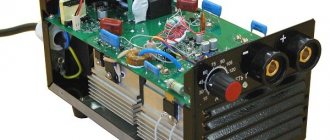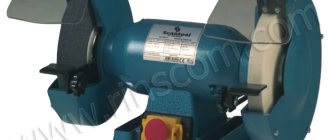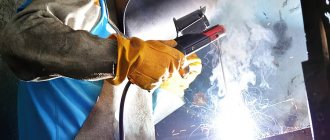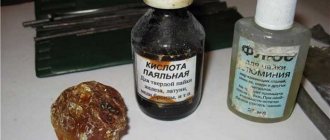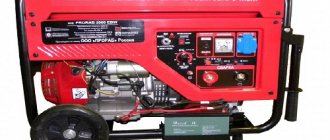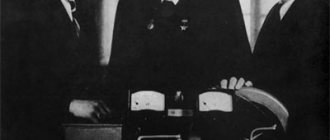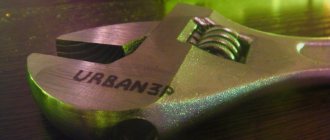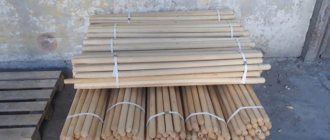Every person in life may have a situation when it is urgently necessary to solder a radiator, zinc bucket, enameled basin or other product. But not everyone has a welding machine or soldering iron at home or in the garage; to work with them you need to have certain skills. Therefore, an easy-to-use welding pencil can be an alternative for home craftsmen. It is used for thermal welding, surfacing and cutting of alloys and metals both in domestic conditions and during emergency rescue operations.
Operating principle
The pencil consists of a compressed mixture of aluminum and iron oxide. When such a material ignites, a large amount of heat is released (exothermic reaction). From a chemical point of view, there is a reduction reaction of Fe from the oxide with the participation of Al. When molecular bonds in the oxide are broken, a release of thermal energy is generated.
The temperature of the reagents rises to such an extent that the reduced iron immediately passes into the liquid phase state, or simply melts. This molten metal penetrates and fills holes, crevices and cracks in the parts being joined or repaired.
Oxygen atoms released from the oxide molecules react with aluminum to form aluminum oxide. It plays the role of a flux, preventing re-oxidation of the melt and areas of the product heated to the plasticity temperature.
The welding pencil contains all the necessary components for welding:
- filler metal to form the weld material;
- flux that protects the weld pool from oxygen and nitrogen in the air;
- source of thermal energy for melting metal.
The chemical composition of pencils may vary. Instead of aluminum, magnesium can be used as a reducing agent. The reducing metal is selected depending on what alloys the specific pencil model is intended for welding.
In pencils intended for welding work on thick parts, a metal rod is inserted in the middle - its metal will be used to form the suture material.
Welding Pencil Manufacturers
There is a wide variety of welding pencils on the welding products market, but you need to buy only from trusted suppliers who produce certified products, which is documented. Such products include the following brands.
- Extra ration. This soldering pen is reusable and has an unlimited service life. It is made using special technology and ensures adhesion to any surface made of plastic, ceramics, metal, in different planes. The manufacturer promises the consumer up to 30 rations with one pencil.
- Nanopike. This is a reliable tool for repairing holes and cracks in cars, plumbing, and household appliances. The manufacturer recommends that before sealing, wipe the damaged area with a rag and clean it with a knife or sandpaper. Light the welding pencil and transfer the molten mass to the soldering site. After burning the molten mass for 15-20 seconds, distribute it over the damaged surface. The renovation is complete. The soldering hardens in 15 minutes, and its complete hardening will occur in 1.5 hours. The manufacturer provides a one-year warranty on soldering. Recommended for working not only with various types of metals, but also with non-metallic surfaces.
- Extreme. This model is a universal thermal solder. Strong soldering is guaranteed due to the use by the manufacturer of tin, lead, as well as aluminum powder and magnesium in the composition of the combustible substance. In addition to metals, the substance contains flux and soldering acid. The scope of application of the pencil is varied. Soldering can be carried out in different planes.
Varieties
Manufacturers throw many brands and models of welding sticks into the market. Not all of them are made with sufficient quality; for some, even the chemical composition remains unclear.
Extrapike
It is better not to experiment and stick to products from manufacturers that have proven themselves over many years:
- Thermal pencil for Extrapike welding. Suitable for repairing and welding deep cracks and through holes in steel, aluminum, alloys, and enameled products. Carries out tinning of surfaces, restoration of the enamel layer. The shelf life is practically unlimited, the consumption during operation is quite high.
- Universal pencil Nanopayk. Manufactured using magnesium as a reducing agent. Can work with any metals and alloys. Noticeably more expensive.
- Extreme. With its help, you can repair metal parts, both with and without enamel coating. Affordable. The manufacturer claims that the strength of the weld reaches 70% of that of a weld made by electric welding.
Welding pencil Extreme
There are other brands of pencils on the market that are similar in quality and capabilities.
What it is?
A welding pencil is nothing more than a thin cylinder with a very moderate length - only 170 mm. The composition of the device is complex: the main part is a metal rod that acts as solder.
This rod is tightly packed with a special compressed flammable composition, which, when burned, works to form a weld pool and melt metal edges.
The covering part is designed to form a melting point with a protective cloud, which inhibits the harmful effects of the external environment on the interaction of metals during the working process.
Welding pencil instructions.
This magnificent gadget is capable of operating at the highest temperatures - up to 2900 ° C, which is why it is sometimes called a thermal pencil. It is designed for welding metals and soldering aluminum and copper alloys.
Using the device is super simple, this is one of its most advantageous aspects. To get started, just set fire to one of the ends of the cylinder and apply it to the surfaces to be joined. To form a seam, you just need to run it along the joint.
Another function is cutting rods and metal plates. In this case, the welding pencil is set on fire and the required place or line is pressed.
Technology of use
The process of using a welding pencil is quite simple and can be done by any home craftsman. The sequence of operations is as follows:
- Prepare the surface thoroughly by cleaning it with a wire brush or abrasive paper to remove rust, old paint residue and other contaminants.
- Degrease with gasoline, white spirit or other solvent.
- Remove the packaging from the pencil. Move the metal cover to the other end of the rod - we will hold it by it.
- Don’t forget to wear welder’s goggles (or mask) and thick canvas (split) gloves.
- Use a match or lighter to heat and set the end of the rod on fire.
- Bring the burning end to the starting point of the weld and press it to the surface of the part. Guide the rod along the seam line, holding in one place for at least 3 seconds, so that the welded edges have time to warm up to the melting temperature.
- Welding is carried out without hesitation, if with the right hand, then from right to left. If the welding speed is too high, the welding gap will fill with slag, but not enough melt will get into it to make a reliable connection.
At the end of the welding work, the stub of the rod must be placed on concrete, the ground (without dry grass) and thrown into a bucket of water.
Heating the metal
The most commonly used means of heating the surface is a gas burner.
It can run on propane or butane. But at home, a regular gas blowtorch is quite suitable.
When heating, you should control your actions so that the elements being connected do not begin to melt. To do this, the surfaces are often touched with solder in order to promptly notice its melting, confirming that the desired temperature has been reached. When heating parts, the burner flame must be monitored. It should be well-balanced, bright blue in color, and small in size.
Advantages and disadvantages of using thermite pencil
The main advantages of a metal welding pencil include:
- Ability to work in the most cramped, hard-to-reach places.
- Energy independence - no sources of electricity or gas are required.
- Small size - fits into a workwear pocket.
- The work does not require long training or special skills.
- Can work both in a workshop and in the field.
- The heat resistance of the seam is up to 180 °C, which makes the device indispensable when repairing household utensils and dishes.
- Cheapness.
Using a Welding Pencil
In addition to the advantages, like any actually used welding method, there are also disadvantages:
- The quality of the seam is lower than with electric or gas welding.
- Not suitable for large volumes of work.
- High material consumption.
The combination of advantages and disadvantages makes the method ideal for minor operational repairs.
Features of connecting some types of seams
A welding pencil (St. Petersburg, Krasnoyarsk, Moscow - these are not all the cities in which you can purchase it) must be used correctly. Different types of seams are processed differently:
- Horizontal ones are most often overlapped. In this case, the materials must be laid on a metal lining, asbestos or brick. Any flammable items are not used in this case, for example: wood, plastic.
- Vertical seams are processed using a special shelf, which is fixed slightly below the soldering area. This helps prevent the molten metal from spreading. The shelf is secured with a clamp.
- To cut metals, you need to melt them much slower than usual. In this case, you do not need a gasket under the materials at all.
What metals can it work with?
Due to their versatility, welding pencils can be used for welding materials such as:
- structural steel alloys;
- galvanized sheet metal;
- cast iron;
- aluminum alloys;
- copper alloys: bronze, brass, etc. ;
- stainless and high-alloy alloys;
- heat-resistant plastics.
Minor repairs with a thermal pencil
Industrial pencils of a special composition are also used for welding other metals, as well as for welding work under water, in a vacuum and other extreme conditions.
Preparing for work
Careful preparation of the workplace and parts to be welded will be the key to high quality and safe welding work.
The workplace must be cleared of flammable materials, fuels and lubricants and other flammable liquids. The parts to be welded must be mechanically cleaned of dirt and degreased.
The parts to be welded must be pressed against each other and securely fixed in a vice, clamps, or other inventory fastening devices.
DIY making
Pencils are freely sold in general construction and specialized welding stores. In addition, they can be made independently.
To begin with, you will need carbon steel alloy wire. The electrode rod is excellent for manual electric welding. The flux coating needs to be removed from it.
Electrodes for manual welding
The composition for its own coating contains:
- one part of aluminum sawdust;
- three parts iron oxide;
- The binder is moment glue or other strong glue.
The preparation of the composition is carried out in a strong and stable container made of glass or clay. The electrode rod (or pieces of wire cut into 15 cm pieces) is dipped into the mixture and layers of the composition are wound onto it by rotating around the axis of the rod.
One end is left clean - it will act as a handle. The other will have the lighter mixture applied to it. It is prepared in a separate container in the following proportion:
- 1 part bertholet salt;
- 2 parts aluminum crushed to sawdust.
After thorough mixing and adding the same glue until a thick viscous mass is formed, small balls are rolled out of it, which are placed on the end of the pencil intended for ignition. Drying time - up to half an hour (or as indicated in the instructions for the glue).
Our welding pencil is ready, we can begin testing and welding training.
Description of the device
A welding stick, or thermal solder, is a thin-walled tube or rod of flammable material. On one side the tube is filled with a dry flammable substance, and on the other it is closed with a plug. The substance is an exothermic mixture that consists of flux and solder.
The diameter of the product can be from 4 to 16 mm , and the length of the tube can be from 7 to 20 mm. Pencil device:
- incendiary mixture;
- exothermic process mixture;
- cardboard sleeve;
- hole for pen holder;
- shell from instruction label;
- outer protective waterproof shell.
The average burning time of the rod is at least 30 seconds, the maximum combustion temperature is from 2200 to 2900 degrees Celsius, the weight is no more than 80 g. Depending on the thickness and type of material, the length of the seam can be from 8 to 15 cm.
Areas of application
The scope of application of welding pencils is the widest. They allow you to weld ferrous and non-ferrous metals in any position and in almost any circumstances, from workshop conditions to field and extreme conditions. The product is widely used in the following areas:
- Installation and emergency work in hard-to-reach places and in emergency situations.
- Prompt repair of vehicles (automobile, water, railway) in places where they break down.
- Repair of rail tracks, switches and crossings.
- Soldering copper wires and other electrical components.
- Repair of cracks in heating system components.
- Elimination of leaks in main and distribution pipelines.
- Repair of cast iron and bronze castings for industrial and decorative purposes.
- Repair of construction and agricultural equipment at remote sites.
Soldering pencil instantly
Welding pencils are especially widely used in rail repairs. Their use makes it possible to carry out routine repairs extremely quickly, inexpensively and with minimal delays in train movement.
It is important to remember that the pencil is intended for quick, temporary repairs at a great distance from repair facilities or in emergency circumstances. For continuous operation, high-quality repairs should be carried out using electric or gas welding.
Product reviews
Naturally, before you buy the specified product, you want to know the opinions of other users about it. If you want to use a welding pencil, reviews will help you decide on the manufacturer and consider the properties of the product.
However, the opinions of other users regarding this issue are contradictory: both negative and positive. For example, it is noted that the product emits a fairly strong fire, and that after its use a very unpleasant odor remains. However, a welding pencil should not smell like toilet water. Many people find the product useful enough to keep in their repair backpack. The excellent cutting properties of this product are noted.
However, almost all users note that it is not worth using it everywhere and always. It is best used for partial or temporary repairs. Next, the damaged area must be thoroughly repaired. It is best to use a pencil in truly extreme situations, when there is simply no other way to achieve the desired result. That's all the features of the product. Good luck!
Rules for safe use
Despite the extreme simplicity of their design and use, welding pencils pose a real threat to health, human life and the safety of material assets. To avoid tragic consequences, safety precautions should be strictly observed:
- Carefully prepare the workplace, remove all combustible and flammable substances and materials.
- Securely secure the workpiece or the product being repaired in a vice, clamps, clamp, etc. Cooking by weight is strictly unacceptable.
- Use only non-combustible materials for seam pads and welding shelves.
- It is mandatory to use personal protective equipment: goggles or a welder’s mask, canvas mittens or split-leaf gloves - leggings, thick clothing and durable shoes that do not leave exposed skin.
- When igniting and welding, you should hold the pencil firmly. Move it along the seam line smoothly, without jerking. It is unacceptable to walk around the workshop with a burning pencil.
- When welding on vertical and inclined surfaces, as well as when cutting metal, carefully ensure that the molten metal does not flow towards you or splash around.
- At the end of welding, the cinder should be thrown into a previously prepared bucket of water or sand. As a last resort - on a concrete or earthen floor. Do not leave the workplace without making sure that the cinder has burned completely.
Proper use of an inexpensive and easy-to-use cooking agent will make working with it convenient and safe.
Safety precautions
When working with a pencil, you must strictly follow safety precautions to avoid getting burns on your body.
- Do not work near flammable liquids or materials.
- The place where welding work is carried out must be provided with fire extinguishing equipment.
- Before welding, you must wear thick gloves, safety glasses or a welding helmet, as well as special clothing.
- Keep the lit thermal solder at a distance from you using pliers or other devices.
- If it is necessary to seal a container after fuels and lubricants, it must be thoroughly rinsed and dried before welding.
- Do not work near electrical wiring that is not de-energized.
- Since the combustion of a dry combustible substance inside a pencil produces smoke, it is not advisable to inhale its vapors.
- When welding fistulas and cracks in batteries and pipes, you must first drain the water.
- After welding work, you need to check that there is no smoldering or fire around.
